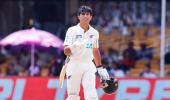IMAGES from Day 4 of the first Test played between India and New Zealand in Bengaluru, on Saturday.

Sarfaraz Khan's maiden century and Rishabh Pant's cavalier 99 is unlikely to prevent New Zealand from earning their first-ever Test match victory on Indian soil in 36 years with only 107 runs to get on the final day of an intriguing start-stop series opener.
Tom Latham (0) and Devon Conway (0) were at crease when bad light and later rain forced early stumps on fourth evening.

The last time New Zealand won a Test match in India was way back in 1989 when Sir Richard Hadlee was still an active Test cricketer and got 10 wickets at the Wankhede to ensure a huge 136-run win.
Tom Latham's team is on cusp of history despite a gallant fightback from India to score 462 in their second innings largely due to Sarfaraz continuing his happy knack of notching up 'Daddy Hundreds' from first-class to Test arena with a brilliant 150 off 195 balls and a stand of 177 with a half-fit Rishabh Pant, who missed his seventh Test hundred by a solitary run.

Once the second new ball was was taken, India lost seven wickets for 54 runs with tall gast bowlers Matt Henry and William O'Rourke getting extra bounce and movement off the Chinnaswamy surface. After all, India were 52 runs ahead with seven wickets in hand. But Latham taking the new ball on the first available opportunity turned the tide in New Zealand's favour.
At that point, hopes were high of a miracle triumph similar to Kolkata 2001 with both Sarfaraz and Pant at the crease.
The first one to perish was Sarfaraz, who spooned Tim Southee to Ajaz Patel at covers and Pant followed soon, dragging William O'Rourke (3/92) on to his stumps.

It was his seventh dismissal in 90s in Test cricket, and he will certainly rue it after doing all the hard work till then.
Henry (3/102), who took five wickets in the first innings, looked pedestrian till then regained his mojo and movement with the new ball, mopped India's tail with the wickets of Ravichandran Ashwin, Mohammed Siraj and Jasprit Bumrah.
But before the Blackcaps' bowlers found some wind in their sails, Sarfaraz and Pant dictated the course of the match like puppet masters.

The sight of Pant walking out to bat in the first session in itself was soothing as he had missed the whole of third day because of the blow he copped on the knee while ‘keeping.
Pant understandably made a slightly gingerly start and was even involved in a mix-up with Sarfaraz, saved only by an erratic throw at stumps by wicketkeeper Tom Blundell.
Once swam past that period, Pant was unstoppable, clobbering left-arm spinner Ajaz Patel for a couple of six.
The left-hander soon brought up his fifty off just 55 balls with a thumping cover drive off Glenn Phillips before rain halted his march.

Despite the break, Pant started the middle session with confidence, biffing left-arm spinner Rachin Ravindra for a couple of sixes over the covers.
There were a couple of jittery moments for him but DRS saved him on both the occasions – once from an appeal for a bat-boot catch and once from a caught-behind appeal.
However, those blips did not affect his concentration and gradually began playing those shots exclusively crafted in the Pant manufacturing unit.
He sashayed and pirouetted around the crease to find all possible angles and the Kiwis bowlers were a clueless lot in finding an ideal line and length against him.
The prime example was an amazing slog swept six off Southee that sailed over the mid-wicket fence as the pacer tried to pitch it full, searching for swing.

Meanwhile, Sarfaraz, at the other end, chugged to a 150 after reaching his maiden Test hundred during the first session of the day, which he celebrated with unbridled joy.
His batting too was far from conventional, dishing out a melange of late cuts to accumulate his runs.
In that sense, the Mumbai man's brusque batsmanship has a close resemblance to Pant's.

In fact, 40 out of his first 100 runs came in the arc between point and third man through late cuts of various nature – dabs, swish swat and an odd upper cut.
When the spinners were introduced, Sarfaraz used sweeps and nudges between square leg and fine leg to collect his runs. He made 39 runs in that region.
Latham struggled to keep a proper field for him. He even had to resort to the unusual placing of three players in the widish arc behind the square of the wicket.
But still Sarfaraz found a way to score runs between them.
However, all those heroics will remain just as a bright footnote unless Indian bowlers conjure some magic of their own on the fifth day.












 © 2025
© 2025